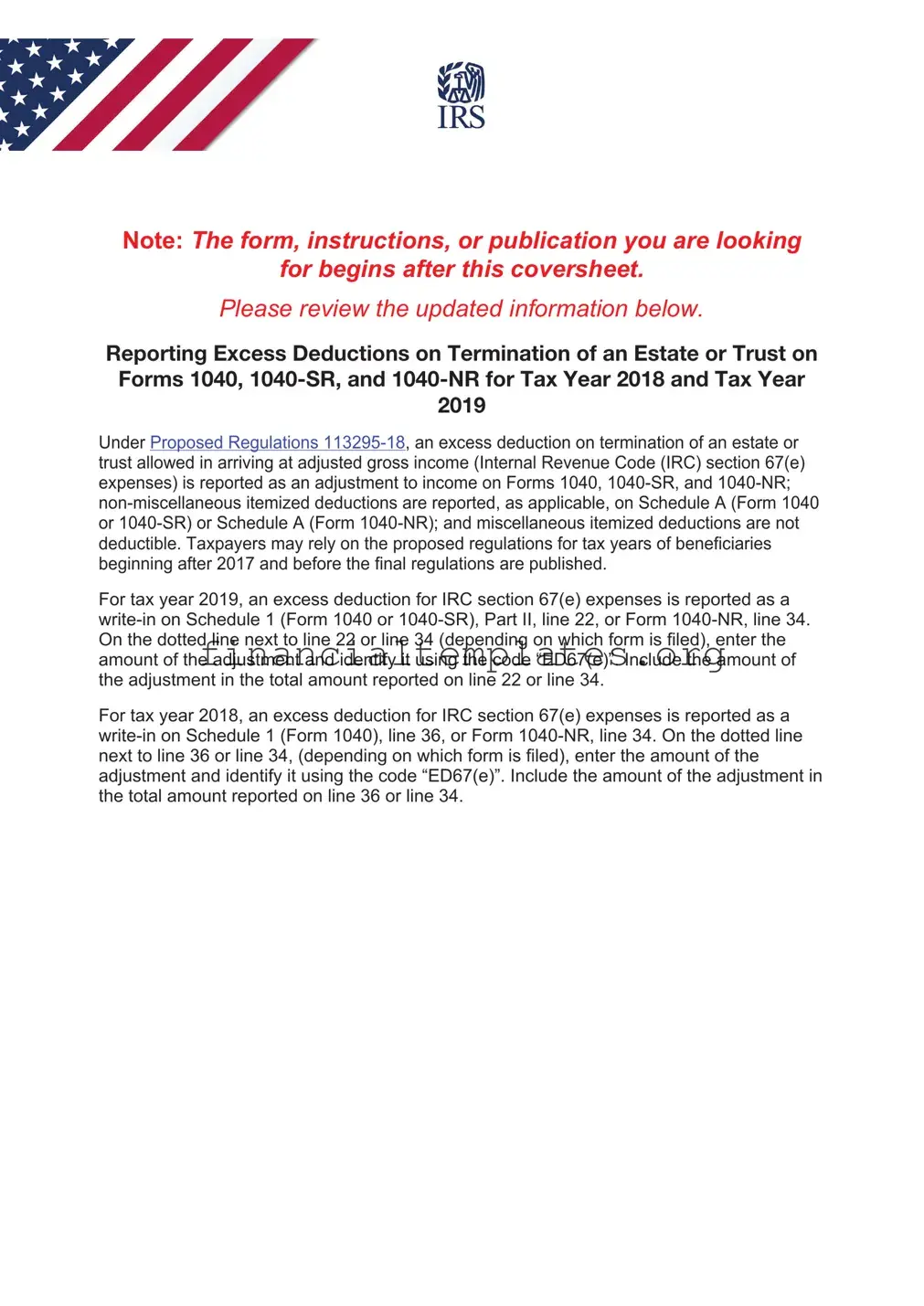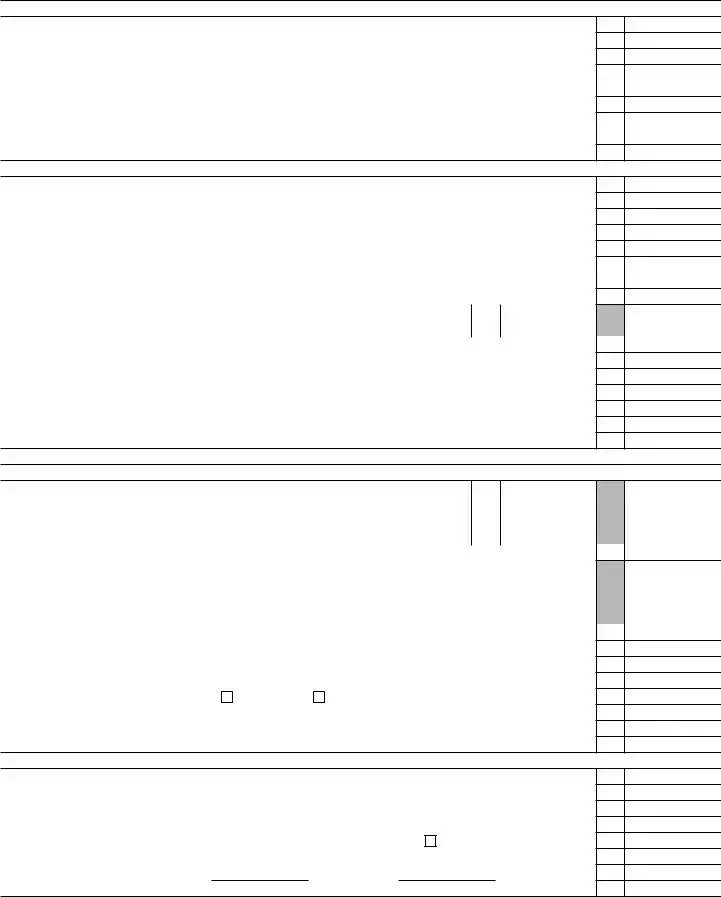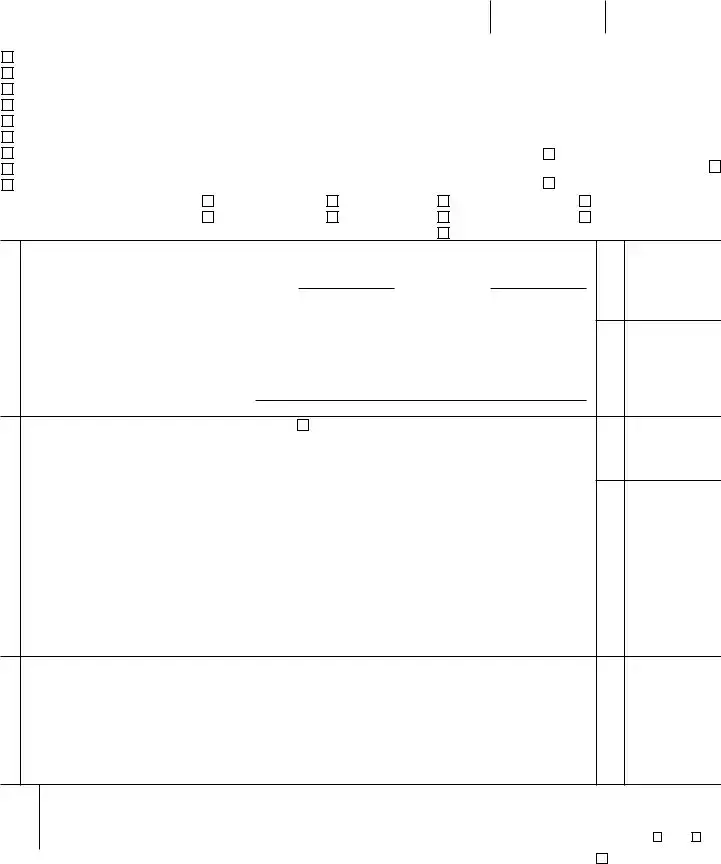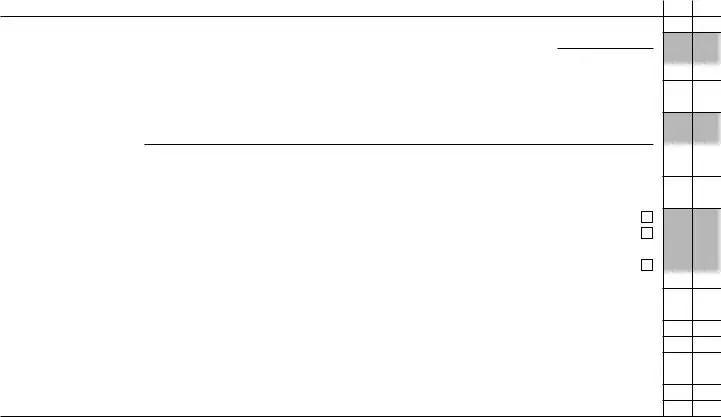1041 |
Department of the Treasury—Internal Revenue Service |
U.S. Income Tax Return for Estates and Trusts |
▶ Go to www.irs.gov/Form1041 for instructions and the latest information. |
|
|
|
|
|
|
|
|
|
|
|
|
|
A Check all that apply: |
For calendar year 2021 or fiscal year beginning |
, 2021, and ending |
, 20 |
|
|
|
|
|
|
|
|
|
|
Decedent’s estate |
Name of estate or trust (If a grantor type trust, see the instructions.) |
|
C |
Employer identification number |
|
|
Simple trust |
|
|
|
|
|
|
|
|
|
|
|
|
|
|
|
|
|
|
|
|
|
Complex trust |
Name and title of fiduciary |
|
|
D |
Date entity created |
|
Qualified disability trust |
|
|
|
|
|
|
|
|
|
|
|
|
|
|
|
|
|
|
|
ESBT (S portion only) |
Number, street, and room or suite no. (If a P.O. box, see the instructions.) |
|
E Nonexempt charitable and split-interest |
|
Grantor type trust |
|
|
|
|
|
trusts, check applicable box(es). |
|
|
|
|
|
|
See instructions. |
|
Bankruptcy estate—Ch. 7 |
|
|
|
|
|
Described in sec. 4947(a)(1). Check here |
|
Bankruptcy estate—Ch. 11 |
City or town, state or province, country, and ZIP or foreign postal code |
|
|
if not a private foundation . . ▶ |
|
Pooled income fund |
|
|
|
|
|
Described in sec. 4947(a)(2) |
|
|
|
|
|
|
|
|
|
|
|
B Number of Schedules K-1 |
F Check |
Initial return |
Final return |
Amended return |
|
Net operating loss carryback |
|
attached (see |
applicable |
Change in trust’s name |
Change in fiduciary |
Change in fiduciary’s name |
Change in fiduciary’s address |
|
instructions) ▶ |
boxes: |
G Check here if the estate or filing trust made a section 645 election . . |
. . . . . . . ▶ |
Trust TIN ▶ |
|
|
|
|
|
|
1 |
Interest income |
. . . . . . . |
. . |
|
1 |
|
|
|
2a |
Total ordinary dividends |
. . . . . . . |
. . |
|
2a |
|
b |
Qualified dividends allocable to: |
(1) Beneficiaries |
(2) Estate or trust |
|
|
|
|
|
Income |
3 |
Business income or (loss). Attach Schedule C (Form 1040) . . . . |
. . . . . . . |
. . |
|
3 |
|
|
4 |
Capital gain or (loss). Attach Schedule D (Form 1041) |
. . . . . . . |
. . |
|
4 |
|
|
|
|
|
|
5 |
Rents, royalties, partnerships, other estates and trusts, etc. Attach Schedule E (Form 1040) |
. . |
|
5 |
|
|
|
6 |
Farm income or (loss). Attach Schedule F (Form 1040) |
. . . . . . . |
. . |
|
6 |
|
|
|
7 |
Ordinary gain or (loss). Attach Form 4797 |
. . . . . . . |
. . |
|
7 |
|
|
|
8 |
Other income. List type and amount |
|
|
|
|
|
8 |
|
|
|
9 |
Total income. Combine lines 1, 2a, and 3 through 8 |
. . . . . . . |
. ▶ |
9 |
|
|
|
10 |
Interest. Check if Form 4952 is attached ▶ |
. . . . . . . . |
. . . . . . . |
. . |
|
10 |
|
|
|
11 |
Taxes |
. . . . . . . |
. . |
|
11 |
|
|
|
12 |
Fiduciary fees. If only a portion is deductible under section 67(e), see instructions . . . . |
. . |
|
12 |
|
|
|
13 |
Charitable deduction (from Schedule A, line 7) |
. . . . . . . |
. . |
13 |
|
|
14Attorney, accountant, and return preparer fees. If only a portion is deductible under section 67(e),
Deductions |
|
|
|
see instructions |
14 |
|
17 |
|
|
Adjusted total income or (loss). Subtract line 16 from line 9 |
. . |
. . . |
17 |
|
|
|
|
|
|
|
15a |
|
Other deductions (attach schedule). See instructions for deductions allowable under section 67(e) |
15a |
|
|
|
b |
|
Net operating loss deduction. See instructions |
15b |
|
|
16 |
|
|
Add lines 10 through 15b |
. . . . . . . . . . . . ▶ |
16 |
|
|
|
|
|
|
|
|
|
|
|
|
|
|
|
|
|
|
|
|
|
18 |
|
|
Income distribution deduction (from Schedule B, line 15). Attach Schedules K-1 (Form 1041) . . |
18 |
|
|
19 |
|
|
Estate tax deduction including certain generation-skipping taxes (attach computation) . . . . |
19 |
|
|
20 |
|
|
Qualified business income deduction. Attach Form 8995 or 8995-A |
20 |
|
|
21 |
|
|
Exemption |
21 |
|
|
22 |
|
|
Add lines 18 through 21 |
. . . . . . . . . . . . ▶ |
22 |
|
Payments |
23 |
|
|
Taxable income. Subtract line 22 from line 17. If a loss, see instructions |
23 |
|
24 |
|
|
Total tax (from Schedule G, Part I, line 9) |
24 |
|
|
|
|
|
|
25 |
|
|
Current year net 965 tax liability paid from Form 965-A, Part II, column (k) (see instructions) . . |
25 |
|
|
26 |
|
|
Total payments (from Schedule G, Part II, line 19) |
26 |
|
and |
27 |
|
|
Estimated tax penalty. See instructions |
27 |
|
28 |
|
|
Tax due. If line 26 is smaller than the total of lines 24, 25, and 27, enter amount owed . . . . |
28 |
|
Tax |
29 |
|
|
Overpayment. If line 26 is larger than the total of lines 24, 25, and 27, enter amount overpaid . . |
29 |
|
30 |
|
|
Amount of line 29 to be: a Credited to 2022 ▶ |
|
; |
b Refunded . . . . . ▶ |
30 |
|
|
|
|
Under penalties of perjury, I declare that I have examined this return, including accompanying schedules and statements, and to the best of my knowledge and |
Sign |
|
belief, it is true, correct, and complete. Declaration of preparer (other than taxpayer) is based on all information of which preparer has any knowledge. |
|
|
|
|
|
|
|
|
|
|
|
|
|
|
|
May the IRS discuss this return |
Here |
|
▲ |
|
|
|
|
|
▶ |
|
|
|
|
|
|
|
|
|
|
|
|
|
|
|
|
|
|
|
|
with the preparer shown below? |
|
|
|
|
|
|
|
|
|
|
|
|
|
|
|
|
|
Signature of fiduciary or officer representing fiduciary |
Date |
|
|
EIN of fiduciary if a financial institution |
See instructions. Yes No |
Paid |
|
|
Print/Type preparer’s name |
Preparer’s signature |
|
|
|
|
Date |
|
Check |
if |
PTIN |
|
|
|
|
|
|
|
|
|
|
|
|
|
|
|
|
|
|
|
|
|
|
|
|
|
|
|
|
|
Preparer |
|
|
|
|
|
|
|
|
|
|
self-employed |
|
|
|
|
|
|
|
|
|
|
|
|
|
|
|
Firm’s name ▶ |
|
|
|
|
|
|
|
|
Firm’s EIN ▶ |
|
|
Use Only |
|
|
|
|
|
|
|
|
|
|
Firm’s address ▶ |
|
|
|
|
|
|
|
|
Phone no. |
|
|
|
|
|
|
|
|
|
|
|
|
|
|
|
|
|
For Paperwork Reduction Act Notice, see the separate instructions. |
|
|
|
Cat. No. 11370H |
|
|
|
|
Form 1041 (2021) |
Schedule A Charitable Deduction. Don’t complete for a simple trust or a pooled income fund.
1Amounts paid or permanently set aside for charitable purposes from gross income. See instructions
2 |
Tax-exempt income allocable to charitable contributions. See instructions |
3 |
Subtract line 2 from line 1 |
4Capital gains for the tax year allocated to corpus and paid or permanently set aside for charitable
purposes . . . . . . . . . . . . . . . . . . . . . . . . . . . . . . .
5 Add lines 3 and 4 . . . . . . . . . . . . . . . . . . . . . . . . . . . .
6Section 1202 exclusion allocable to capital gains paid or permanently set aside for charitable
purposes. See instructions . . . . . . . . . . . . . . . . . . . . . . . . .
7Charitable deduction. Subtract line 6 from line 5. Enter here and on page 1, line 13 . . . . . .
Schedule B Income Distribution Deduction
1 |
Adjusted total income. See instructions |
1 |
2 |
Adjusted tax-exempt interest |
2 |
3 |
Total net gain from Schedule D (Form 1041), line 19, column (1). See instructions |
3 |
4 |
Enter amount from Schedule A, line 4 (minus any allocable section 1202 exclusion) |
4 |
5 |
Capital gains for the tax year included on Schedule A, line 1. See instructions |
5 |
6Enter any gain from page 1, line 4, as a negative number. If page 1, line 4, is a loss, enter the loss as a
|
positive number |
6 |
|
7 |
Distributable net income. Combine lines 1 through 6. If zero or less, enter -0- |
7 |
|
8 |
If a complex trust, enter accounting income for the tax year as determined |
|
|
|
|
|
under the governing instrument and applicable local law |
8 |
|
|
|
9 |
Income required to be distributed currently |
9 |
|
10 |
Other amounts paid, credited, or otherwise required to be distributed |
10 |
|
11 |
Total distributions. Add lines 9 and 10. If greater than line 8, see instructions |
11 |
|
12 |
Enter the amount of tax-exempt income included on line 11 |
12 |
|
13 |
Tentative income distribution deduction. Subtract line 12 from line 11 |
13 |
|
14 |
Tentative income distribution deduction. Subtract line 2 from line 7. If zero or less, enter -0- . . . |
14 |
|
15 |
Income distribution deduction. Enter the smaller of line 13 or line 14 here and on page 1, line 18 . |
15 |
|
Schedule G Tax Computation and Payments (see instructions)
Part I — Tax Computation
1 |
Tax: |
|
|
|
|
|
a |
Tax on taxable income. See instructions |
|
1a |
|
b |
Tax on lump-sum distributions. Attach Form 4972 |
|
1b |
|
c |
Alternative minimum tax (from Schedule I (Form 1041), line 54) |
|
1c |
|
d |
Total. Add lines 1a through 1c |
. . . . . . . ▶ |
2a |
Foreign tax credit. Attach Form 1116 |
|
2a |
|
b |
General business credit. Attach Form 3800 |
|
2b |
|
c |
Credit for prior year minimum tax. Attach Form 8801 |
|
2c |
|
d |
Bond credits. Attach Form 8912 |
|
2d |
|
e |
Total credits. Add lines 2a through 2d |
. . . . . . . ▶ |
3 |
Subtract line 2e from line 1d. If zero or less, enter -0- |
4 |
Tax on the ESBT portion of the trust (from ESBT Tax Worksheet, line 17). See instructions . . . . |
5 |
Net investment income tax from Form 8960, line 21 |
6 |
Recapture taxes. Check if from: |
Form 4255 |
Form 8611 |
7 |
Household employment taxes. Attach Schedule H (Form 1040) |
8 |
Other taxes and amounts due |
9Total tax. Add lines 3 through 8. Enter here and on page 1, line 24 . . . . . . . . . . . ▶
Part II — Payments
10 |
2021 estimated tax payments and amount applied from 2020 return |
10 |
|
11 |
Estimated tax payments allocated to beneficiaries (from Form 1041-T) |
11 |
|
12 |
Subtract line 11 from line 10 |
12 |
|
13 |
Tax paid with Form 7004. See instructions |
13 |
|
14 |
Federal income tax withheld. If any is from Form(s) 1099, check here ▶ |
. . . . . . . . . |
14 |
|
15 |
Current year net 965 tax liability from Form 965-A, Part I, column (f) (see instructions) |
15 |
|
16 |
Other payments: a Form 2439 |
; b Form 4136 |
; Total . . |
▶ |
16c |
17 |
Credit for qualified sick and family leave wages for leave taken before April 1, 2021 |
17 |
|
18 |
Credit for qualified sick and family leave wages for leave taken after March 31, 2021 |
18 |
|
19 |
Total payments. Add lines 12 through 15 and 16c through 18. Enter here and on page 1, line 26 . |
▶ |
19 |
|
Form 1041 (2021)
Form 1041 (2021) |
Page 3 |
Other Information |
Yes No |
1Did the estate or trust receive tax-exempt income? If “Yes,” attach a computation of the allocation of expenses.
Enter the amount of tax-exempt interest income and exempt-interest dividends . . . ▶ $
2Did the estate or trust receive all or any part of the earnings (salary, wages, and other compensation) of any
individual by reason of a contract assignment or similar arrangement? . . . . . . . . . . . . . . .
3At any time during calendar year 2021, did the estate or trust have an interest in or a signature or other authority over a bank, securities, or other financial account in a foreign country? . . . . . . . . . . . . . .
See the instructions for exceptions and filing requirements for FinCEN Form 114. If “Yes,” enter the name of the foreign country ▶
4During the tax year, did the estate or trust receive a distribution from, or was it the grantor of, or transferor to, a
foreign trust? If “Yes,” the estate or trust may have to file Form 3520. See instructions . . . . . . . . .
5Did the estate or trust receive, or pay, any qualified residence interest on seller-provided financing? If “Yes,” see
the instructions for the required attachment . . . . . . . . . . . . . . . . . . . . . . .
6 If this is an estate or a complex trust making the section 663(b) election, check here. See instructions . . ▶
7To make a section 643(e)(3) election, attach Schedule D (Form 1041), and check here. See instructions . . ▶ 

8If the decedent’s estate has been open for more than 2 years, attach an explanation for the delay in closing the
estate, and check here . . . . . . . . . . . . . . . . . . . . . . . . . . . . ▶ 
 9 Are any present or future trust beneficiaries skip persons? See instructions . . . . . . . . . . . . .
9 Are any present or future trust beneficiaries skip persons? See instructions . . . . . . . . . . . . .
10Was the trust a specified domestic entity required to file Form 8938 for the tax year (see the Instructions for
Form 8938)? . . . . . . . . . . . . . . . . . . . . . . . . . . . . . . . . . .
11a Did the estate or trust distribute S corporation stock for which it made a section 965(i) election? . . . . . .
bIf “Yes,” did each beneficiary enter into an agreement to be liable for the net tax liability? See instructions . . .
12 Did the estate or trust make a section 965(i) election for S corporation stock held on the last day of the tax year?
See instructions . . . . . . . . . . . . . . . . . . . . . . . . . . . . . . . . .
13 ESBTs only. Does the ESBT have a nonresident alien grantor? If “Yes,” see instructions . . . . . . . .
14ESBTs only. Did the S portion of the trust claim a qualified business income deduction? If “Yes,” see instructions
Form 1041 (2021)







